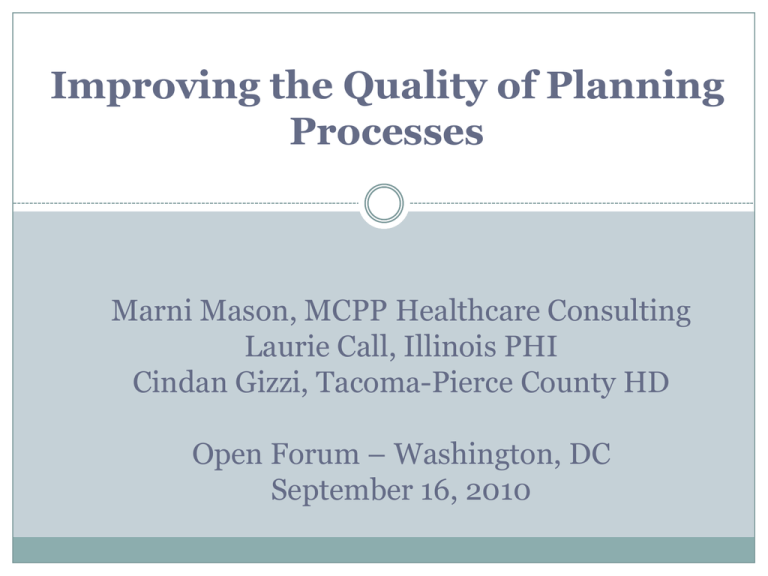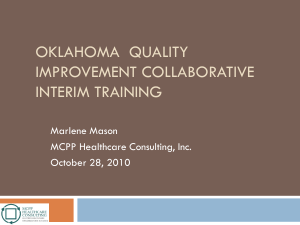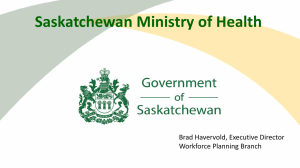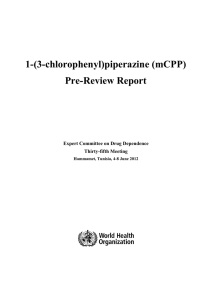Improving the Quality of Planning Processes
advertisement

Improving the Quality of Planning Processes Marni Mason, MCPP Healthcare Consulting Laurie Call, Illinois PHI Cindan Gizzi, Tacoma-Pierce County HD Open Forum – Washington, DC September 16, 2010 Objectives for Session 2 Discuss the need, methods and tools for improving planning processes Review three phases of quality trilogy and how they relate to each other Review the application of QP methods to improve planning processes in local health departments Illinois MLC-3 Collaborative on CHIP Tacoma-Pierce County Health Department MCPP Healthcare Consulting Projects to Conduct Planning 3 Some projects to plan services to address new or emerging issues aren’t a good fit for “traditional” quality improvement methods and tools, such as Rapid Cycle Improvement (RCI) Excellent for the Collaborative or Breakthrough Method from Institute of Healthcare Improvement (IHI) Do benefit from AIM statements and from using the Plan-Do-Study-Act cycle MCPP Healthcare Consulting When is Quality Planning project appropriate? 4 Service/process has never existed before Customer requirements are not known Existing service/process performance is not capable of meeting customer requirements Service/process is ad hoc; extremely variable; never been well defined or worked on before as a whole Unstable environment – major market, technology, organizational change No performance data exists or would take excessive time/expense to collect data MCPP Healthcare Consulting Quality Planning 5 J. Juran* described three basic managerial processes to manage quality: Quality Planning (QP) Quality Control (QC) and Quality Improvement (QI) Juran Trilogy Purpose for QP is to provide the organization with the means to provide services that can meet client and stakeholder needs. Quality control is needed to stabilize a process and to hold the gains made through QI efforts. *Juran on Planning for Quality, pg. 11 MCPP Healthcare Consulting QP compared with QI 6 How does quality planning differ from project-by- project quality improvement? Juran uses example of an alligator infested swamp and the difference between removing alligators individually (QI) or draining the swamp to remove all the alligators at once (QP).* Another description is the difference between improving an existing work activity, action or intervention and the method used to design a new program or activity. *Juran on Planning For Quality MCPP Healthcare Consulting Quality Planning Roadmap* 7 In broad terms, QP consists of developing services and processes required to meet stakeholders’ needs Identify stakeholders and their needs Develop an activity or program to address the needs (establish stakeholder related measures) Optimize the program or service activities to meet health department needs Develop a work process to conduct the services and interventions Optimize the work process, prove that it delivers the results needed Implement the program or service in the health department *Juran on Planning For Quality MCPP Healthcare Consulting Application in PH 8 PH already has expertise in parts of the quality planning process MAPP, Sector Mapping, Partner Tool, Program Development, many others Strengthen QP step of optimizing program to meet HD and stakeholder needs Force Field Analysis, Meeting Effectiveness, Interrelationship Digraph, Failure Mode Analysis, many others Strengthen step of optimizing the work processes to achieve desired results Common QI tools-work flows, fishbone diagrams, PDSA cycles Implement only after program and work processes have been optimized to deliver results MCPP Healthcare Consulting Quality Planning Cycle 9 Define Opportunity & Stakeholder Needs Take Action •Problem/Opportunity to Address •Identify clients/stakeholders and needs •Translate stakeholders needs •Establish performance measures based on needs •Fully implement if expected outcomes achieved •Initiate QI if outcomes not achieved Design & Pilot Service/Process •Develop activity to meet needs •Establish outcome measures •Implement service/process Monitor Impact/Results of Service •Measure Outputs and Outcomes •Compare actual results to expected results MCPP Healthcare Consulting Quality Control - Program Performance % of Chlamydia clients w/out treatment 10 30% 20% 10% 0% QI – Rapid Cycle Improvement 11 Mod el for Im p rovem ent What are we trying to ac c om plish? How will we know tha t a c ha nge is an im provem ent? Ac t Stud y Pla n Do Sequential PDSA Cycles for RCI 12 A P S D Breakthrough Results A P S D A P S D A S Theories, hunches, & best practices P D Spread Implement Test new conditions Test a wider group Test on a small scale The Quality Trilogy (adapted from Juran) 13 Quality Planning Quality Control & Improvement (During Operations) Model for Improvement Sporadic Spike Define Opportunity & Stakeholder Needs Take Action What are we trying to acc omplish? How will we know that a change is an improvement? Original Zone of Quality Control Design & Pilot Service or Process Ac t Begin Monitor Impact / Results of Service Opeartions Study Process not Achieving Desired Results (An Opportunity for Improvement) MCPP Healthcare Consulting Plan Do New Zone of Quality Control Quality Improvement Time Examples of Tools for Quality Planning 14 Sector Mapping to identify Key Stakeholders and their needs Force Field Analysis to identify driving forces and restraining forces Meeting Effectiveness Tool to improve the participation and contribution of community partners MCPP Healthcare Consulting Sector Maps for Planning –Public Sector 15 Health & Human Services •Center for Disease Control & Prev. •Center-Medicaid &Medicare Services •Fed. Drug •Administration Dept. of Social & Human Services Office of the Insurance Commissioner Governor / Legislature Employment Security Department Department of Health •Community & Family Health •Women, Infants & Children •Licensing Boards Tribal Government Health Care Authority School Boards •Public Schools (K-12) •Private Schools (K-12) Local Health Jurisdictions Rural & Community Health Centers Local Government Public Library System Indian Health Service State Board of Health Bullets refer to examples of organizations and are not a comprehensive listing. MCPP Healthcare Consulting Example of Community-Based Sector 16 Service Organizations •Thousands of community-based agencies: specific partners will be identified in each community Communities of Color Organizations United Way Senior Centers Faith-based Community Organizations Community Centers Youth Associations •YMCA / YWCA •Boys & Girls Club •Boy & Girl Scouts of America •Campfire Girls and Boys American Association of Retired Persons Community Health Alliances Youth Sports Associations Churches, Temples & Mosques •Little League •Pop Warner •Soccer, etc Community Health Centers •Federally Qualified Health Centers •Migrant Health Centers Community-based Daycare Sites •All ages •Birth to 3 childcare Bullets refer to examples of organizations and are not a comprehensive listing. MCPP Healthcare Consulting Force Field Analysis 17 Why use it? To identify the forces and factors in place that support or work against the solution of an issue or problem so that the positives can be reinforced and/or the negatives eliminated or reduced. What does it do? Presents the positives and negatives of a situation so that they can be compared Forces people to think about all aspects of making a desired change a permanent one Encourages honest reflection and agreement about the relative priority of factors on each side of the “balance sheet” PH Memory Jogger pg. 63 MCPP Healthcare Consulting 18 Example- AIM for Meeting Effectiveness 19 What are We Trying to Accomplish? Increase the effectiveness of Community Health Improvement Plan (CHIP) coalition meetings and maximize stakeholder participation. We do this in order to increase member engagement and contribution to the implementation of the CHIP. MCPP Healthcare Consulting Evaluating Meeting Effectiveness 20 MCPP Healthcare Consulting How Will We Know When We Get There? Measurements 21 Increase in meeting attendance (% of members that regularly attend) Increase in effectiveness (% of members rating meetings as effective or valuable) Increase in engagement (% of members rating their commitment as high) Increase in participation (% of members that contribute resources to CHIP activities) MCPP Healthcare Consulting Effectiveness Ratings – Adams Co., IL 22 5.00 4.50 4.00 3.50 3.00 2.50 2.00 5/11/2009 1.50 7/13/309 1.00 9/14/2009 0.50 11/9/2009 MCPP Healthcare Consulting Value of meeting goals Effectiveness Participation Communication Clear goals Commitment to the group 0.00 In Summary… 23 Using Quality Planning methods and tools can improve public health planning processes Build on proven practices from other health departments Be intentional about which methods and tools to use for improvement based on the topic and needs Remember to plan for holding the gains and sustaining improvement (quality control) MCPP Healthcare Consulting Laurie Call Director Center for Community Capacity Development Illinois Public Health Institute laurie.call@iphionline.org Illinois QI Learning Collaboratives •Two Collaboratives, 22-months long, operating simultaneously •Community Health Improvement Planning (CHIP) 6 teams (RED) •Preventable Risk Factors for Chronic Disease (CD) – 4 teams 25 Plan 1. Identify and Prioritize Opportunities 2. Develop AIM Statement 3. Describe the Current Process 4. Collect Data on Current Process 5. Identify All Possible Causes 6. Identify Potential Improvements Adapted from The ABC’s of PDCA, Gorenflo and Moran 7. Develop Improvement Theory 8. Develop Action Plan Check/ Study 1. Review analysis and make conclusions Act Do 1.Test the Improvement 2. Collect and Analyze the data 3. Document Problems, Observations, and Lessons Learned 26 Adopt Standardize/ Hold the Gains Adapt DO Modify/ Try Again Abandon Plan Plan Identify and Prioritize Opportunities Develop AIM Statements Describe the Current Process Collect Data on Current Process Identify all Possible Causes Identify Potential Improvements Develop Improvement Theory Develop Action Plan 27 Types of Goals for Improving CHIP in Illinois 28 MAPP Strategic Issues have at least one strategy map/related measurable objectives w/ strategies for action to improve community health PH System partners will commit resources to implement CHIP to improve community health Use of data to generate and align community resources with effective strategies to reduce obesity Increase external (outside LHD) leadership and ownership of CHIP development/ implementation to increase community health Increase diversity, commitment and productivity of the CHIP team and their ownership of implementation of the CHIP to increase community health AIM Development 29 Same process was used for CHIP teams Multiple iterations of AIMs Baseline data was challenging/ different for teams to grasp Types of Baseline Data for QI/QP of CHIP 30 Comprehensive System Partner Lists Previous CHIP Committee Participants Previous Participation Levels/Roles by Organization, Individual Previous Resources (amount/type) Contributed by Organizations Process Documentation (How were things done?) Community Health Plan Progress Past Meeting Evaluation Results/ Feedback Etc….. Stakeholder Analysis Identify Stakeholders 31 Identify Stakeholder Needs Establish Performance Measures Based on Needs Develop Activities and Services to Meet Needs Adapted from Joseph Juran, “Juran on Quality Planning” This information caused some teams to revisit their AIM statements and measures. Kane County 32 Kane County 33 Clay County Community Health Committee Formation Process Flow 34 (reorganized every 5 years) 35 Workflow Analysis Adams County 36 37 38 Peoria County 39 Knox County 40 Affinity Diagram, Knox County LHD 41 42 Peoria County Plan Identify and Prioritize Opportunities Develop AIM Statements Describe the Current Process Collect Data on Current Process Identify all Possible Causes Identify Potential Improvements Develop Improvement Theory Develop Action Plan 43 44 Quality Planning Cycle 45 Define Opportunity & Stakeholder Needs •Problem/Opportunity to Address •Identify clients /stakeholders and needs •Translate stakeholders needs •Establish performance measures based on needs Take Action •Fully implement if expected outcomes achieved •Initiate QI if outcomes not achieved Monitor Impact/Results of Service •Measure Outputs and Outcomes •Compare actual results to expected results MCPP Healthcare Consulting Design & Pilot Service/Process •Develop activity to meet needs •Establish outcome measures •Implement service/process Do Test the Improvement Collect and Analyze the Data Document Problems, Observations, and Lessons Learned Study Review Analysis and Make Conclusions 46 47 Comparing Participant Evaluation Data Peoria County Meeting Effectiveness Measurements Adams County 48 49 Act Adopt • Standardize • Hold the Gains Adapt • DO • Modify/Try Again Abandon • Plan • Repeat Cycle 50 Quality Planning Cycle with QI Infused Define Opportunity & Stakeholder Needs Plan Take Action Design & Pilot Service or Process Act Do Study Monitor Impact / Results of Service 51 Resources and Sharing 52 Visit IPHI Website for more project related information: www.iphionline.org Webinars are posted on the IPLAN Website under Public Health Quality Improvement Webinars and can be found here: http://app.idph.state.il.us/Resources/training.asp?menu=3 Pierce County, Washington Public Health Quality Model 54 Assess •Consider goals and current performance •Prioritize opportunities Community Health Assessment Define Community Health Improvement Planning •Problem/Opportunity •Process to be addressed •Measure(s) of success Evaluate Analyze • Monitor progress • Act on exceptions •Analyze process/data •Identify Root Cause(s) Change • Develop solutions • Manage and Implement Change Same Basic Method … Different Applications 55 QI Toolbox QC Toolbox QP Toolbox The QI-QP “Hybrid” Project 56 Projects can start with a QI approach and not find narrow “root” causes Large portions or even all of the process may need to be re-designed Even standard QI projects can sometimes benefit by “borrowing” from the QP toolbox “The Liger is pretty much my favorite animal” -- Napoleon Dynamite Quality Planning Project Steps Assess 1. Assess organizational goals and current performance 2. Determine most important problems/biggest opportunities Define 3. Define problem/opportunity 4. Define process(es)/service to be addressed 5. Define measure(s) of success 6. Define stakeholders, customers and team Analyze (Diagnose) 7. Determine customer needs 8. Translate customer needs into service features 9. “Benchmark” other service providers 57 Change (Implement Solutions) 10. Consider service/process design options 11. Determine supplier requirements 12. Determine “best” integrated design 13. Prevent Failure 14. Manage Change Social Technical 15. “Hand-off” to operations – including Evaluation plan Evaluate (Control) 16. Monitor performance against measures 17. Maintain process (if working) 18. Enter Quality Improvement Cycle Why Obesity Prevention? 58 Two of our 12 departmental (strategic) performance measures Percent of adults who are obese. Percent of youth who are physically active for at least 60 minutes per day. One of our three priority health indicators Percent of adults who are obese (significantly higher rate than state average AND significantly worsening trend) Physical Activity & Nutrition Program 59 Decrease adult & childhood obesity SCHOOLS COMMUNITY PLANNING/GOVT. SNAP Ed Community Gardens Comprehensive Plans policies, systems & programs policies, systems, environmental change & programs policies & environmental change Safe Routes to School systems & programs Improve School Meals policies, systems & programs School Wellness Policies policies, systems, environmental change & programs Healthy Retail Stores systems and environmental change ACHIEVE (Community Coalition) policies & systems change Non-Motorized Transportation and Complete Streets policies & environmental change Application of QP: Consultation for City Planners 60 Original concept: Hire a temporary, part-time health educator to provide consultation services to city planners to include built environment concepts into next round of plans. QP tools used: customer interviews Results: Customers didn’t need the services; program not implemented. Application of QP: Healthy School Grants Program 61 Original concept: Offer mini-grants to school districts to choose from a menu of “best practice” policies and systems-level interventions QP tools to be used: customer needs analysis, benchmarking, process controls, performance measures Results: TBD •Momentum •Opportunity •Evaluation Surveys Focus Groups BRFSS/ HYS Anecdotal •Political Dr. Chen directive •PAN Planning QP Model: Healthy School Grants ASSESS DEFINE See QP/ QI Project Definition document Customer Needs • ACHIEVE 5 Strategies EVALUATE • Informal conversations with project team/ schools ANALYZE In Process Benchmarking • Evidenced based best practices Topic areas How to strategies CHANGE (i.e. the PROCESS) Letter to School Districts RFP/ RFA Published Applications Reviewed School Districts Notified 62 Internal Grants Process Funds Awarded DRAFT August 18, 2010 Solutions and Controls 63 Harder to sustain performance • • • • • • • • • Documented paper process Controlled electronic process Training Performance Aids Audits Reminders Check lists Measurement feedback Hard controls Easier to sustain performance Control Examples 64 Reminder signs Automated messages File “Out” cards Forms Tracking boards/electronic tracking Check sheets “Kanban” inventory controls Required electronic fields Exception reports Control charts (and other graphic measurement tools) What questions do you have? 65 Laurie Call, Director Center for Community Capacity Development Illinois Public Health Institute laurie.call@iphionline.org 217-679-2827 Cindan Gizzi, MPH Community Assessment Manager Tacoma-Pierce County Health Dept. 253/798-7695 cgizzi@tpchd.org Marni Mason MCPP Healthcare Consulting 206-613-3339 marni@mcpp.net MCPP Healthcare Consulting








